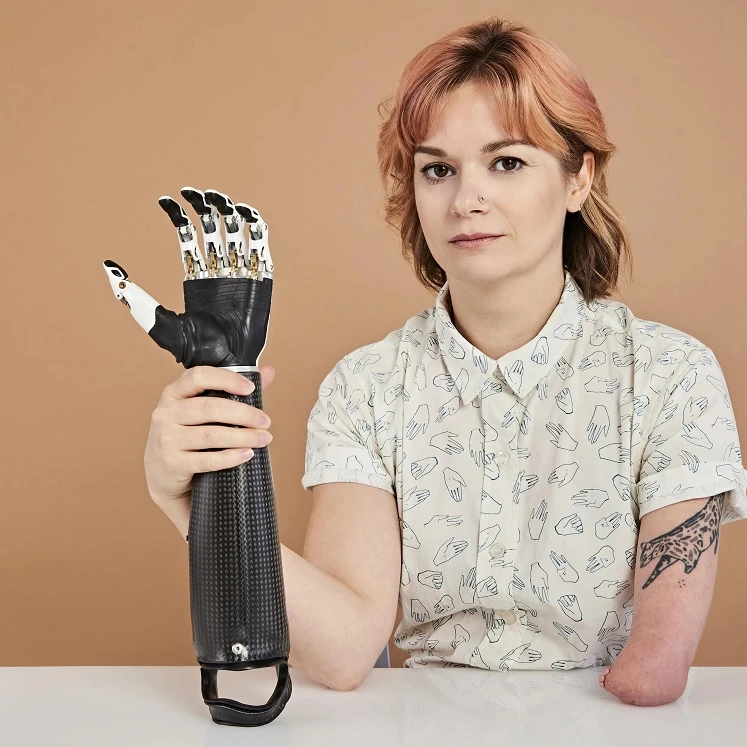We do our best to showcase writing by amputee authors in Amplitude‘s pages, but it’s always nice to see other publications providing similar opportunities. So we were heartened to see new articles recently from two of our favorite amputee scribes, Chloe Valentine Toscano and Britt H. Young. Both appeared in high-profile outlets, and both pieces shared perspectives about limb loss that don’t typically get covered in popular media.
This week, we came across two other thought-provoking pieces from a couple of new amputee voices. All four pieces are worthy of your attention; see excerpts and links below. Happy reading!
“The Bionic-Hand Arms Race,” by Britt H. Young
“It’s time to ask who prostheses are really for, and what we hope they will actually accomplish. Each new multigrasping bionic hand tends to be more sophisticated but also more expensive than the last, and less likely to be covered (even in part) by insurance. And as recent research concludes, much simpler and far less expensive prosthetic devices can perform many tasks equally well. . . . . The vast majority of people who use a prosthetic limb are unilateral amputees—people with amputations that affect only one side of the body—and they virtually always use their dominant ‘fleshy’ hand for delicate tasks such as picking up a cup. Both unilateral and bilateral amputees also get help from their torsos, their feet, and other objects in their environment; rarely are tasks performed by a prosthesis alone. And yet, the common clinical evaluations to determine the success of a prosthetic are based on using only the prosthetic, without the help of other body parts. Such evaluations seem designed to demonstrate what the prosthetic hand can do rather than to determine how useful it actually is in the daily life of its user.” Read the whole thing at IEEE Spectrum.
“6 Things That Make Styling My Hair With One Arm Easier,” by Chloe Valentine Toscano
“I’ve had to relearn plenty of tasks after the accident that caused the eventual amputation of my arm, and handling my hair has been the hardest. Born with naturally rebellious hair, I rarely found styling easy even with two arms. I definitely had no idea how to even gather my hair into one hand, let alone secure a hair tie around the ponytail. The worst part for me, though, was that I felt like I was the only person in the world who was going through this. . . . As hairstylist Michael Rockafellow tells Allure, developing skills in the one-armed hairstyling arena is more than possible. The St. Louis-based stylist, born with one arm, pursued his passion of becoming a hairstylist. ‘At first, I wasn’t sure if a client would even trust me to do their hair with one arm. That [thought] kicked my confidence down,’ shares Rockafellow. But despite being told it wouldn’t be possible, he has overcome most obstacles with practice and adaptations.” Read the whole thing at Allure.
“What Bicycling Means to Me,” by Kyle Stepp
“It wasn’t until my left leg was amputated above the knee that I started taking my passion and love for cycling to the next level. Not only did I turn my pain into purpose, but I also found healing, confidence, self-love, and pride in being an amputee. . . . My number-one goal is to learn as much as possible, fall in love with the process, lean into the beautiful community of para athletes and enjoy the freedom that cycling and triathlon bring me. When I am out riding at sunrise, crushing mountain passes, or competing in the Paratriathlon National Championships, I am not disabled, a cancer survivor, or a childhood trauma survivor. I am an athlete and a human living to experience freedom.” Read the whole thing at Bicycling Magazine (via AOL).
“What Happens When a Manufacturer Owns the [O&P] Clinic?” by WHYY
[NOTE: This is an excerpt from a radio segment, not a print article.] “Given how much patients value their relationship with their prosthetists, some worry what could happen with a recent industry-wide change in the U.S. The two dominant prosthetic manufacturers globally are Ottobock and Össur. Both have bought clinics in the U.S. in recent years, including the one that Ed Nathan goes to. ‘If all the small practices get gobbled up by these large prosthetic manufacturers, I’m concerned that amputees are going to be at risk of becoming square pegs that are forced to fit into round holes just because this is what they want to recommend as a prosthetic system. And it doesn’t always work,” [Mary] White said. Jeffrey Brandt, founder and chairman of Ability Prosthetics and Orthotics, said there is ‘only upside for patients.’ He said being owned by a manufacturer gives the company access to more resources, and a larger network of clinics across the U.S and the world. He said it means his employees can provide better service by learning from more clinics.” Read the whole story at WHYY.
